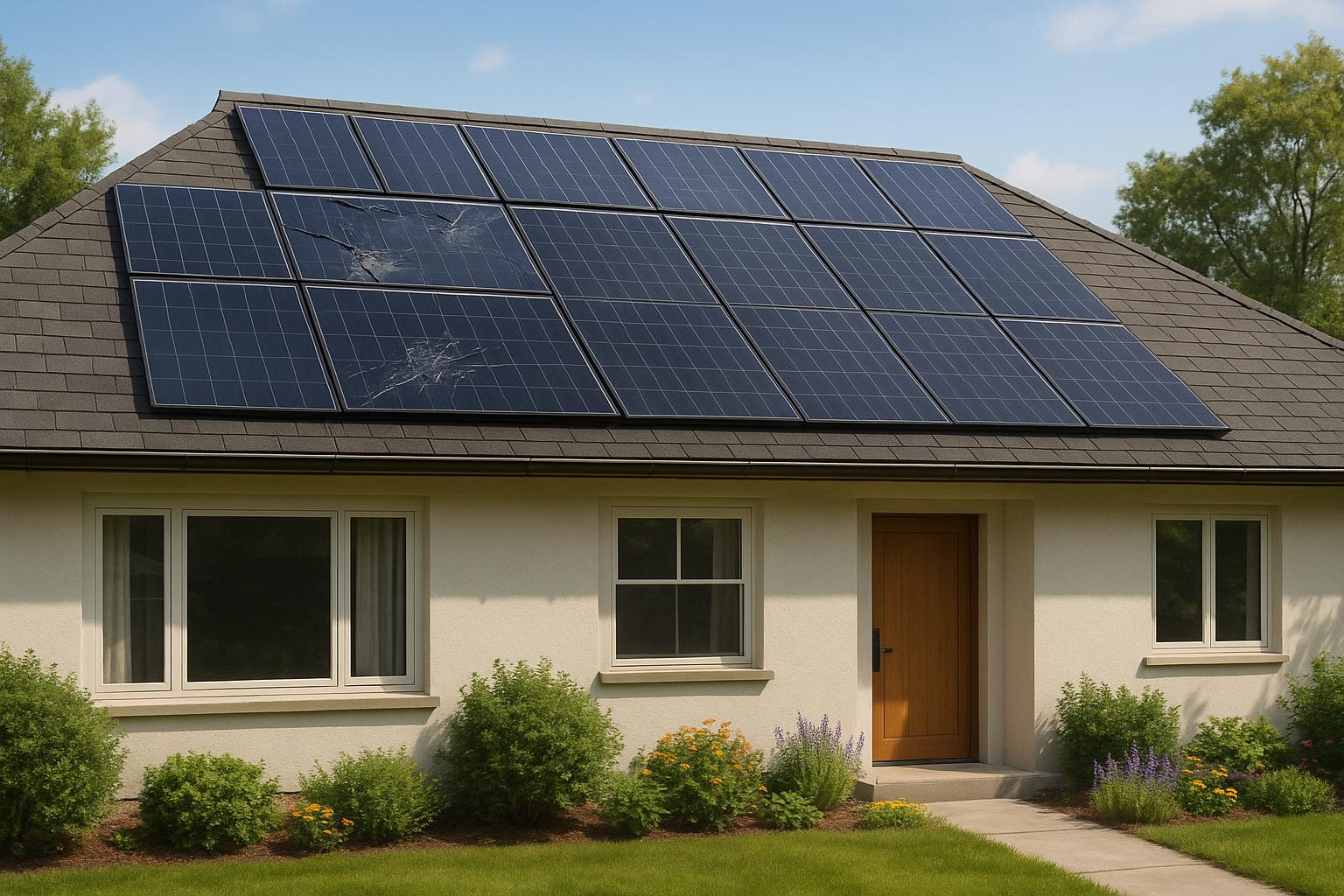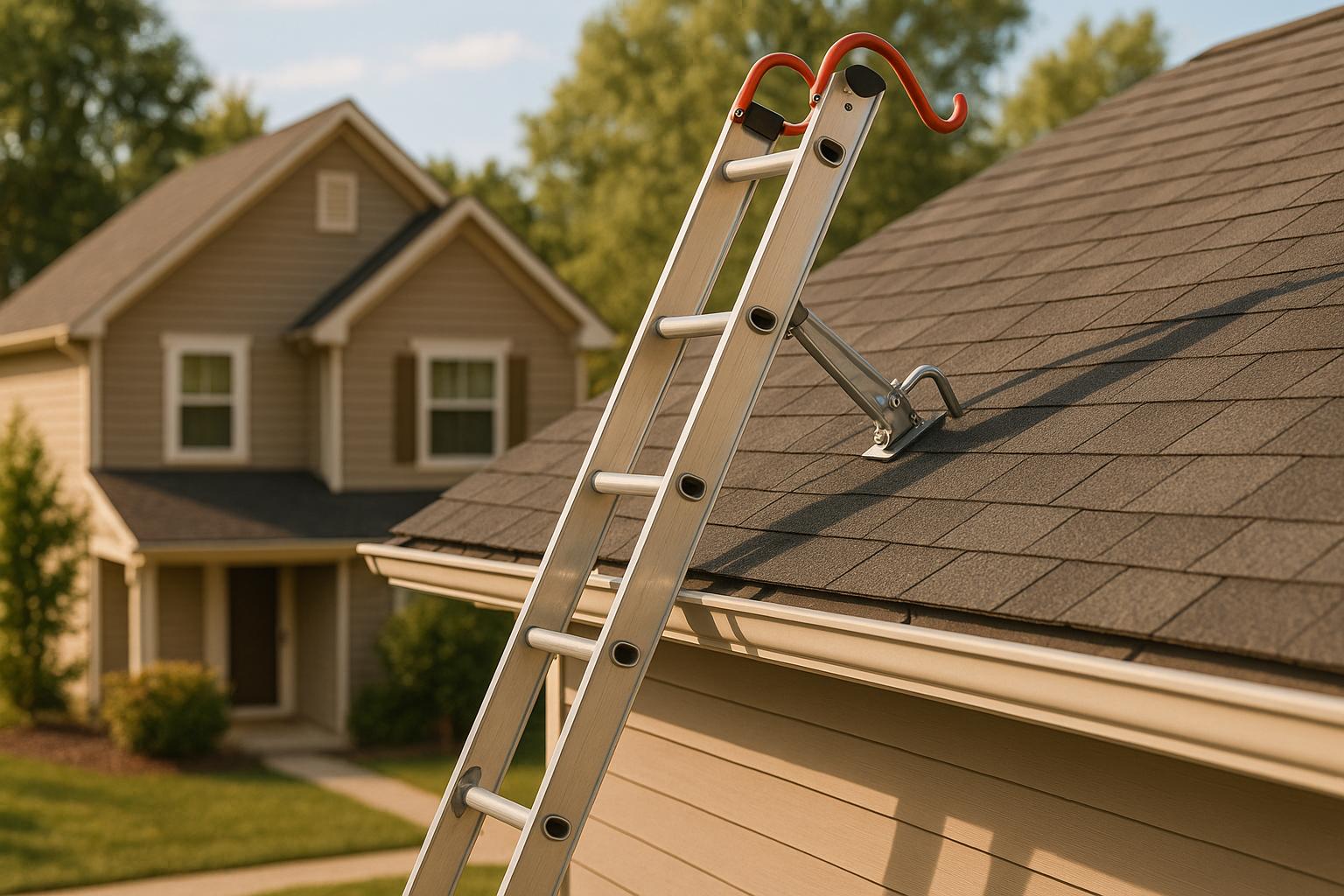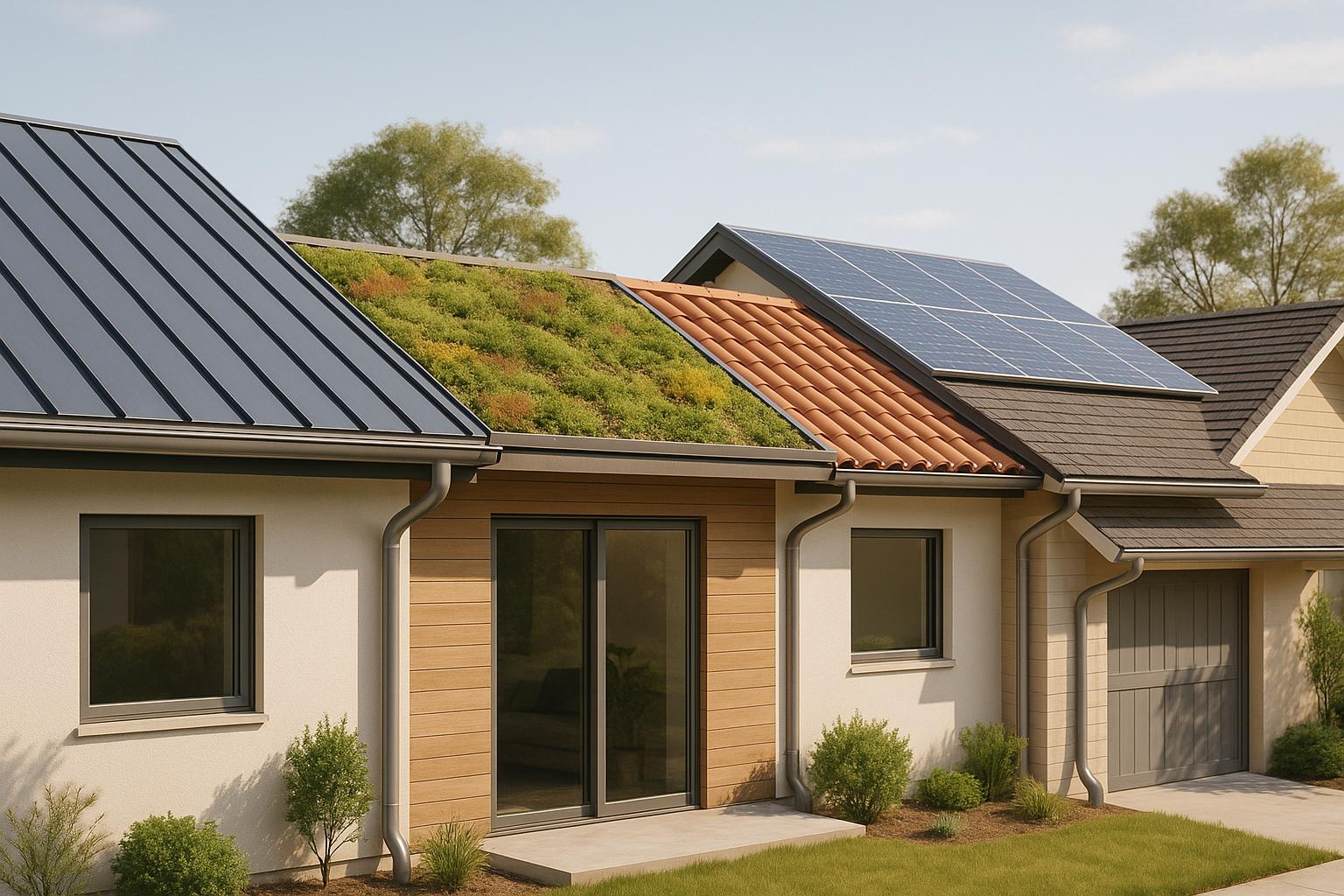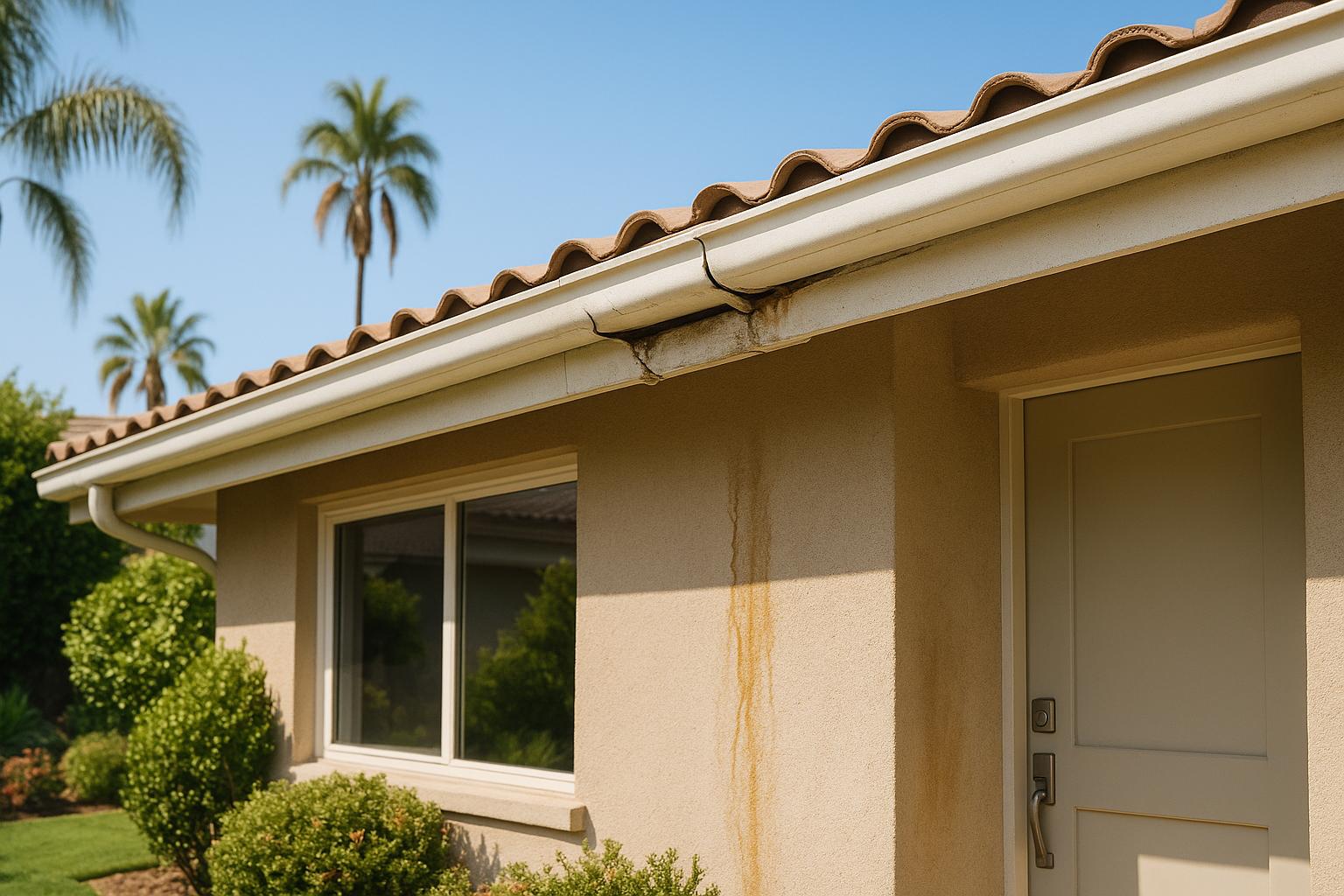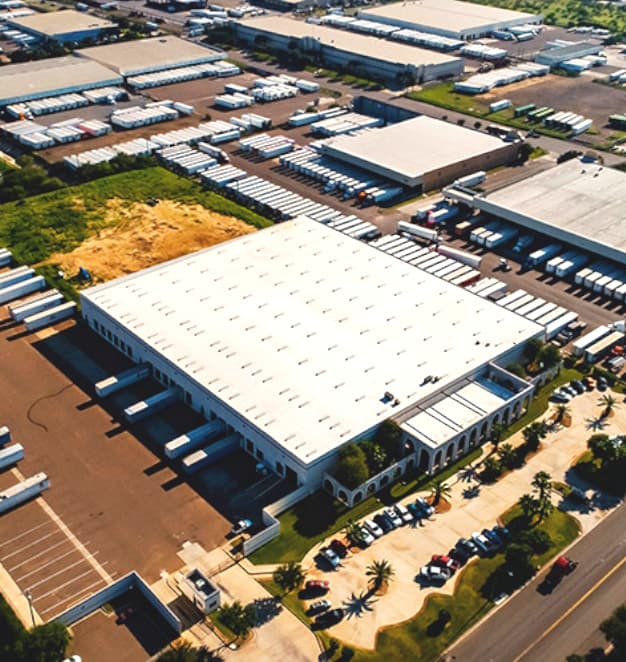Solar roofs are a smart investment, but they come with challenges. Common issues include reduced energy production, cracked panels, and water leaks. These problems can lower efficiency, cause safety risks, and lead to costly repairs if ignored.
Key Takeaways:
- Energy Loss: Issues like panel discoloration, hotspots, and microcracks can cut system efficiency by up to 50%.
- Physical Damage: Cracks, often caused by weather or thermal stress, can worsen over time.
- Water Leaks: Poor installation or damaged flashing can cause leaks, leading to roof rot and electrical hazards.
- Weather Risks: Hail, wind, and heavy rain are top culprits for damage.
- Maintenance Matters: Neglecting upkeep can reduce efficiency by 15–25%.
Solution: Regular inspections, professional repairs, and proactive maintenance are critical to keeping your solar roof in top condition. Prime American Roofing offers specialized services to address these challenges and protect your investment.
🌧️ How to Fix Roof Leaks Under Solar Panels: Easy Step-by-Step Guide 🏠💡
Types of Solar Roof Damage
Solar-integrated roofs face a unique set of challenges that can affect energy production and structural stability. Spotting these issues early is critical to protecting your investment. Here’s a closer look at common problems that can impact both performance and safety.
Reduced Energy Production
When your solar system’s energy output drops under normal conditions, it’s often a sign of trouble. Monitoring system performance and comparing it with expected output can uncover hidden issues before they escalate into expensive repairs.
Since 2019, hardware-related underperformance in solar systems has surged by 214% – leading to an estimated $10 billion in lost energy value globally by 2024. Common culprits behind reduced energy production include panel discoloration, hotspots, diode failure, shading, microcracks, and Potential Induced Degradation. Each of these issues can significantly lower your system’s efficiency.
To catch these problems early, keep an eye out for visible signs like discoloration or drops in output. Regularly monitor your system’s performance and conduct inspections throughout the day to ensure everything is functioning as it should.
Cracks and Broken Panels
Even minor physical damage to solar panels can disrupt power flow and compromise safety. Small cracks can reduce efficiency by up to 2%, while severe breaks may cut efficiency by 50% or more and create electrical hazards. In rare cases, such as when micro-fractures expand over time, the damage can lead to complete panel failure or even shut down the entire system.
Though the chance of solar panel failure is extremely low – less than 0.1% of cases – it’s important to act quickly if you notice cracks or other visible damage. Micro-fractures, often caused by thermal stress or minor impacts, can worsen over time, so professional inspections are essential to prevent further deterioration. Addressing issues early can save you from costly repairs and ensure your system operates safely and efficiently.
Water Leaks and Moisture Problems
Water damage is a serious threat to solar roof systems, affecting both the panels and the roof itself. Installation flaws or damaged flashing can allow water to seep in, leading to roof rot, ruined insulation, and electrical shorts. Poor installation may also disrupt water flow, causing pooling and leaks that accelerate structural damage.
Roof-related issues, including leaks and structural weaknesses, account for about 30% of solar panel failures. Water intrusion not only shortens the system’s lifespan but can also create safety hazards by damaging electrical components. Additional factors like critters nesting under panels or inadequate ventilation can worsen moisture problems.
To prevent water damage, ensure the roof is properly waterproofed before installation, replace any damaged flashing, and use the right underlayment. Regular roof maintenance and inspections are key to catching potential issues early. Look for signs like dark spots, streaks, or visible damage near your solar panels. Checking that flashing and mounting points are securely sealed can also help keep water out and protect both your roof and your energy system.
What Causes Solar Roof Damage
Understanding what leads to solar roof damage is key to protecting your investment. While solar systems are built to handle tough conditions, certain factors can still affect their performance and durability. These issues often tie back to the installation and maintenance practices discussed earlier.
Weather and Storm Damage
Extreme weather poses one of the biggest risks to solar-integrated roofs. Flooding, high winds, hail, wildfires, and lightning can all harm photovoltaic systems. For instance, wind, hail, and snow can create stresses that crack solar modules. Most systems are designed to handle hailstones up to 1.75 inches in diameter, but problems arise when weather conditions exceed those limits.
Flooding and heavy rain are the most common culprits for outages, followed by high winds. Severe weather events can reduce a solar panel’s output by around 1% per occurrence, and outages typically last two to four days. This contributes to an annual performance loss of roughly 1%.
Experts highlight that better-quality equipment and improved installation methods can enhance a system’s ability to withstand these challenges.
Wind damage is particularly concerning because high winds can loosen mounting systems, creating gaps that let water seep in. Hail can cause micro-fractures in panels, which worsen over time, while heavy snow can strain panels beyond their limits. Even dust storms and wildfires can leave debris on panels, reducing their efficiency and leading to the formation of hot spots.
Installation Errors
Improper installation is another major cause of solar roof damage. Mistakes during installation can create weak points that lead to long-term issues. Common errors include incorrect drilling, failing to seal mounting points properly, and overlooking the roof’s structural capacity.
Electrical problems caused by poor installation are also a concern. Loose wiring, improper grounding, and insufficient safety measures can lead to fire hazards and reduced system performance. Additionally, poorly installed flashing can allow water to seep into the roof, and failing to follow manufacturer guidelines for mounting systems – such as proper spacing and torque – can void warranties and increase safety risks.
These issues highlight the importance of professional installation and regular maintenance to catch problems early.
Lack of Regular Maintenance
Skipping regular maintenance can significantly impact the performance of a solar roof. Small issues, like dirt or debris buildup, can escalate if ignored. For example, dirty solar panels can lose between 15% and 25% of their efficiency, and overall energy losses from neglect can range from 10% to 25%. Simple maintenance tasks, like monthly inverter checks and annual wiring inspections, can prevent these losses and reduce fire risks.
Here’s a quick look at a basic maintenance routine:
| Maintenance Task | Frequency | Consequence of Neglect |
|---|---|---|
| Panel Cleaning | 2–4 times/year | 15–25% efficiency loss |
| Visual Inspection | Quarterly | Escalation of undetected damage |
| Inverter Monitoring | Monthly | 10–15% of system issues |
| Wiring Check | Annually | Increased fire and safety risks |
Additionally, trimming nearby trees and bushes is essential. Overgrown vegetation can cast shade or physically damage solar panels. Leaves, bird droppings, and dust not only block sunlight but can also trap moisture, speeding up corrosion of the frames and mounting hardware. Regular upkeep not only ensures efficiency but also helps maintain warranty compliance.
sbb-itb-d1d6490
How to Fix Solar Roof Damage
Taking care of your solar roof promptly ensures both the roof’s durability and the continued efficiency of your solar system.
Regular Inspections and Monitoring
Scheduling yearly professional inspections is a smart way to catch early signs of wear and inefficiencies. These inspections can uncover issues like cracked panels, debris accumulation, or worn-out seals around panel mounts that could lead to leaks. Professionals also clear away debris that might trap moisture and compromise your roof’s integrity.
Modern solar systems often come with monitoring apps that make it easy to track energy performance. A sudden drop in energy output? That could be a red flag for problems like damaged panels or debris blocking sunlight. Keeping a detailed record of these maintenance activities is also helpful for warranty claims.
When inspections reveal problems, timely action – like replacing damaged panels or shingles – becomes essential to avoid bigger headaches down the road.
Replacing Damaged Panels and Shingles
Replacing solar panels is not something you should tackle yourself. It’s a job for professionals who can safely disconnect the system, remove the mounting hardware, and clean and reseal the affected areas. Proper reinstallation is key – panels need to be set at the correct angle, and screws should be tightened just right to avoid future issues.
On average, replacing a solar panel can cost between $1,000 and $3,000, while additional roof repairs might add up to $1,500. It’s a worthwhile investment to ensure everything is functioning smoothly.
Fixing Leaks and Water Damage
Leaks can be more than just an annoyance – they can lead to structural damage, mold, and even electrical hazards. After replacing damaged panels or shingles, addressing leaks immediately is crucial.
Simple sealants won’t cut it for long-term protection. Professionals use metal flashing, installed in line with manufacturer specifications, to ensure a watertight seal. This extra step helps prevent leaks and secures the attachment of your solar panels.
"You’re poking a hole in a perfectly good, sealed roof, and a solar installer does not want to be responsible for any leaks… [Sealants have] been a learning curve for solar people because they’re not roofers, and this is very invasive to the roofing material." – Rocky Stroud, national sales manager at Chem Link
Preventive maintenance is just as important. Clear leaves and branches that can create water dams, prune trees to avoid falling debris, and replace any missing or damaged shingles promptly. For particularly tricky situations, you might need an extra waterproof layer, like a roof coating system for low-sloped roofs, or even a full roof replacement if the underlayment is compromised. Adequate attic insulation can also help by reducing temperature changes and condensation.
When it comes to complex repairs, working with a professional solar installer is invaluable. They bring the right tools, techniques, and safety measures to protect your roof and panels while working at heights.
Prime American Roofing offers specialized solar roof repair services across Southern California, blending roofing expertise with solar know-how to tackle both structural issues and energy efficiency challenges effectively.
Preventing Solar Roof Damage
Avoid expensive repairs and keep your solar roof running efficiently with a proactive maintenance approach.
Keeping Debris Clear
One of the easiest ways to protect your solar roof is by keeping it clean. Dust, dirt, leaves, bird droppings, and other debris can block sunlight and reduce your panels’ efficiency. If left unaddressed, this buildup can even lead to long-term damage. According to a study by the National Renewable Energy Laboratory, regular maintenance can boost energy production by about 15%.
Plan to clean your panels at least twice a year – or more often if you live in a particularly dusty area. Cleaning early in the morning is ideal to avoid sudden temperature changes that could harm the panels. Use a soft brush, sponge, or gentle spray, and steer clear of abrasive tools or harsh chemicals that could damage the protective coatings.
Tree maintenance is another key step. Overhanging branches can cause shading, drop debris, or even fall during storms, all of which can harm your solar roof. Regularly trimming trees near your home helps prevent these risks.
For those living in snowy climates, gentle snow removal is essential. Use a soft brush or snow rake to clear snow without scratching the panels. Installing screens or squirrel guards can also protect your roof from animals that might cause damage. Keeping your solar panels clear of debris works hand-in-hand with weatherproofing measures to ensure your system stays in top shape.
Weather Protection Methods
Solar panels are built tough, capable of withstanding winds up to 140 mph and hail nearly an inch in diameter traveling at 50 mph. Even so, taking extra precautions during severe weather can go a long way in protecting your investment.
Before a storm hits, secure loose outdoor items like patio furniture or tools to prevent them from becoming projectiles. Powering down your system before major storms can help avoid damage from power surges, and ensuring your home battery is fully charged provides backup power if needed. It’s also a good idea to keep updated photos of your panels and components for insurance purposes.
Interestingly, a National Renewable Energy Laboratory study of 50,000 solar systems installed between 2009 and 2013 found that just 0.1% experienced damage or performance issues annually. This highlights how well-designed solar roofs can handle extreme conditions when properly installed and maintained.
"Protecting your roof from storm damage is essential in ensuring the longevity and structural integrity of your home." – Frederic Roofing
To add an extra layer of protection, you might consider upgrading to impact-resistant shingles or metal roofing materials. These options are particularly effective against hail and flying debris.
Professional Maintenance Services
While regular cleaning and weatherproofing help, professional inspections are vital to ensure every part of your solar roof is functioning properly. Annual inspections by trained professionals can catch small issues – like loose bolts, worn seals, or early electrical problems – before they become costly repairs. This is especially important for safeguarding your system over its 25–30 year lifespan.
During a professional inspection, technicians typically check the inverter, examine wiring and connections, ensure roof penetrations are sealed, and assess the overall condition of the panels and mounting systems. These thorough evaluations not only optimize performance but can also improve energy production by around 15%. Regular professional maintenance is a smart way to protect your investment and maximize energy savings over time.
For homeowners in Southern California, Prime American Roofing offers specialized solar roof maintenance services. Their team combines roofing expertise with solar system knowledge, delivering the care your system needs to perform at its best.
Conclusion
Damage to solar roofs can lead to a range of issues, including reduced energy output, physical damage to panels, water leaks, and electrical failures. These problems not only impact performance but can also compromise safety and the structural integrity of your home. Addressing them promptly is essential to avoid expensive repairs and potential hazards.
The best way to safeguard your investment is through immediate, professional repair and maintenance. Regular upkeep by experts can maintain up to 95% of your system’s efficiency, while neglect can cause efficiency to plummet by as much as 30%. This stark contrast underscores the financial risks of delaying necessary care and highlights the importance of professional attention.
When it comes to solar roof care, professional services are indispensable. DIY repairs often lead to improper fixes, voided warranties, and missed issues like microcracks, which are invisible to the naked eye but can severely impact panel performance. Professionals not only identify these hidden problems but also ensure repairs address both the solar components and roofing materials, maintaining compatibility and functionality.
Southern California’s intense sun, heavy rains, and strong winds create unique challenges that require tailored maintenance strategies. Local expertise is crucial for navigating these environmental factors. Prime American Roofing, for example, combines deep knowledge of roofing and solar systems with an understanding of regional weather patterns and building codes. As Tony Mirzakhanyan of Prime American Roofing explains, “Working in a professional and responsible team is essential for delivering high-quality roofing services. Collaboration ensures that each aspect of the project, from initial assessment to final installation, is executed with precision and expertise”.
Annual inspections, swift action when issues arise, and proactive care are your best defenses against costly repairs. By prioritizing professional maintenance, you’ll protect your property value, optimize energy savings, and ensure your solar roof delivers safe, reliable performance for years to come.
FAQs
How can I prevent water leaks in my solar roof, and how often should I perform maintenance?
Preventing water leaks in solar roofs starts with correct installation and consistent upkeep. A few key practices include using durable flashing materials like metal or rubber membranes, ensuring all flashing is tightly sealed, and keeping roof drainage pathways clear of any blockages. Adding waterproof coatings or membranes can provide an extra layer of defense against leaks.
To keep your solar roof functioning well, plan for annual inspections to identify potential problems, reseal vulnerable areas when needed, and remove debris from the roof. If you live in a region with heavy rainfall, strong winds, or harsh weather conditions, you might need to perform inspections more often to maintain the roof’s durability and efficiency.
What are the early warning signs of reduced energy output in solar roofs, and how should homeowners address them?
Homeowners can spot early signs of reduced energy output from their solar roofs by watching for a few key indicators. These include noticeable drops in energy production, visible damage to the roof or panels, unusual sounds, or irregular readings from the inverter. Any of these could signal an issue affecting the system’s performance.
To tackle these concerns quickly, start by checking for common culprits like dirt, debris, or shading that might be blocking the panels. If the problem doesn’t clear up, it’s time to call in a qualified roofing or solar expert. They can inspect the system, pinpoint the issue, and handle necessary fixes – whether that means cleaning the panels, repairing electrical connections, or replacing damaged parts. Staying on top of regular maintenance can also help avoid future problems and keep your solar roof running smoothly.
What are the risks of repairing a solar roof yourself, and why should you hire a professional?
Taking on DIY solar roof repairs might seem like a cost-saving idea, but it comes with serious risks. You could face electrical shocks, fire hazards, or even falls, all of which can lead to severe injuries or worse. Beyond the personal danger, attempting repairs without the right training can damage your roof or solar panels, void warranties, and hurt your system’s energy output – potentially costing you more in the long run.
By hiring a professional, you ensure the job is done safely and correctly. These experts have the tools and know-how to handle electrical work, avoid accidents, and keep your system running efficiently. Professional maintenance not only protects your investment but also brings peace of mind, knowing your roof and solar panels are being cared for by skilled hands.

